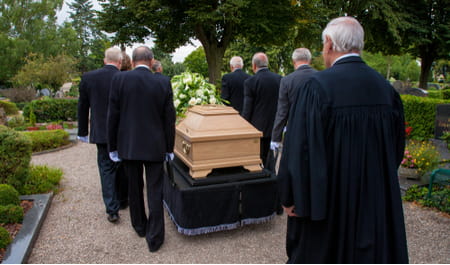The term “pallbearer” derives from “pall,” which refers to the cloth that is typically draped over a casket during the funeral procession and “bear,” which means to carry. Today, the casket and pall are both carried by the same people: the pallbearers.
Origin of the Pallbearer
In Ancient Rome, when an individual died, the family was responsible for transporting the body from the family home to the cemetery for burial. During the processional, the deceased’s cloak, or “pallium” was draped over the coffin.
As the cemetery was often far from the home of the deceased, close male friends and relatives were tasked with carrying the coffin.
By the Middle Ages, the pallium was replaced by a large square, ornate cloth, which was referred to as a “pall.” During the funeral procession, casket bearers were responsible for carrying the casket, while a second group of men, referred to as the pallbearers, held the edges of the pall to ensure it didn’t blow away.
As the traditions surrounding funerals changed with time, so too did the job descriptions of the participants. By the early 1900s, the coffin and pall were both carried by the same group of individuals, who were referred to as pallbearers or casket-bearers interchangeably.
The Pall
A pall is a heavy, square, ornate cloth that is typically draped over the casket during a funeral procession. The pall is typically placed on the casket as soon as it enters the church, and remains on the casket until just before it is lowered into the ground at the cemetery.

The color and design of the pall are dependent on religious and cultural traditions. In Christian ceremonies, the pall is typically white, as a symbolic connection to the white clothing worn by the deceased during baptism. In United States military funerals, the pall is replaced with a national flag, which is ceremonial folded and presented to the family members of the deceased before the coffin is lowered into the ground.
The Etymology of “Pallbearer”
The term “pallbearer” is derived from two words: “pall,” which refers to the cloth that is typically draped over a casket during the funeral procession, and “bear,” which means to carry. Therefore, a pallbearer is someone who is responsible for carrying the casket during a funeral.
The term “pall” is additionally defined by Merriam-Webster’s Dictionary as “an overspreading element that produces an effect of gloom” and “a feeling of gloom.”
Scholars are therefore divided on the exact origin of the name “pall” for the casket cloth. While some argue that it is simply a shortening of the Roman “pallium,” others contend that it is based on the gloom that is felt when funeral goers see the pall-covered casket.
Regardless of which theory is correct, the terms “pall” and “pallbearer” are nonetheless fitting titles.
The Role of Pallbearers Today
Today, pallbearers are typically close relatives, friends, or colleagues of the deceased. At most traditional funerals, pallbearers are responsible for carrying the casket from the funeral home to the hearse, from the hearse to the church, and then from the church to the cemetery.
A typical adult casket in the United States weighs anywhere from 200 to 400 pounds, not including the added weight of the deceased. The casket is fitted with six handles and is carried by six pallbearers- three on each side.
In the United States and Canada, the pallbearers typically carry the casket by the handles at waist height. In other countries, such as the United Kingdom, Australia, Ireland, and most Asian countries, the coffin is carried on the shoulders of the pallbearers.
In both cases, pallbearers typically wear white gloves while carrying the casket; both to show respect to the deceased and to ensure that the casket is not damaged or scuffed while it is carried.
For funerals where the deceased has been cremated, the cremation urn will typically be carried by a single pallbearer.
Honorary Pallbearers

People who escort the casket, but do not actually carry it, are called honorary pallbearers. Honorary pallbearers typically walk either behind or directly in front of the casket.
The status of honorary pallbearer is usually assigned to:
- Family members or close friends who are physically unable to carry the casket;
- Younger family members or close friends;
- A distinguished member of the deceased’s professional field.
Unlike the typical pallbearer position, there is no limit to the number of honorary pallbearers that can be assigned. Honorary pallbearers have become more common in the United States as technological advances and cremations have begun to supplant the role of the pallbearer.

Sources:
https://www.loveliveson.com/why-are-pallbearers-called-that-and-other-facts-you-need-to-know/
https://www.merriam-webster.com/dictionary/pallbearer
http://www.a-to-z-of-manners-and-etiquette.com/pallbearers.html
https://www.thespruce.com/pallbearer-etiquette-1216568
https://www.dignityfunerals.co.uk/advice/a-guide-to-being-a-pallbearer/
https://www.everplans.com/articles/how-to-choose-pallbearers-for-your-funeral

